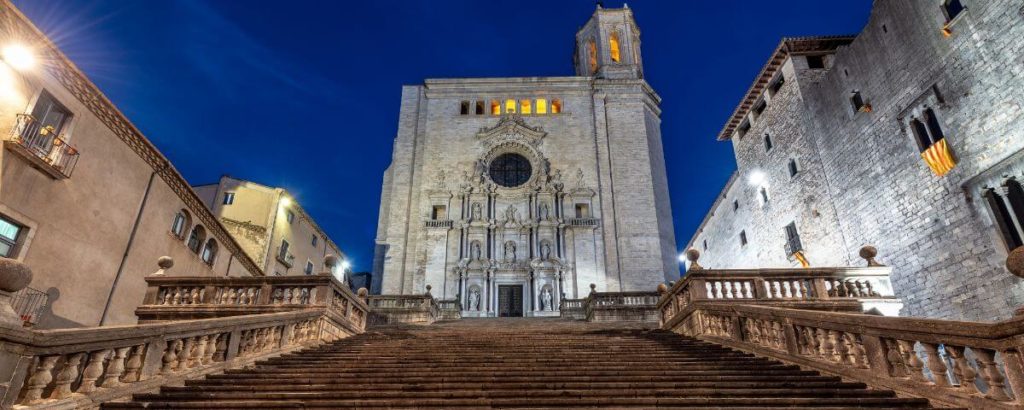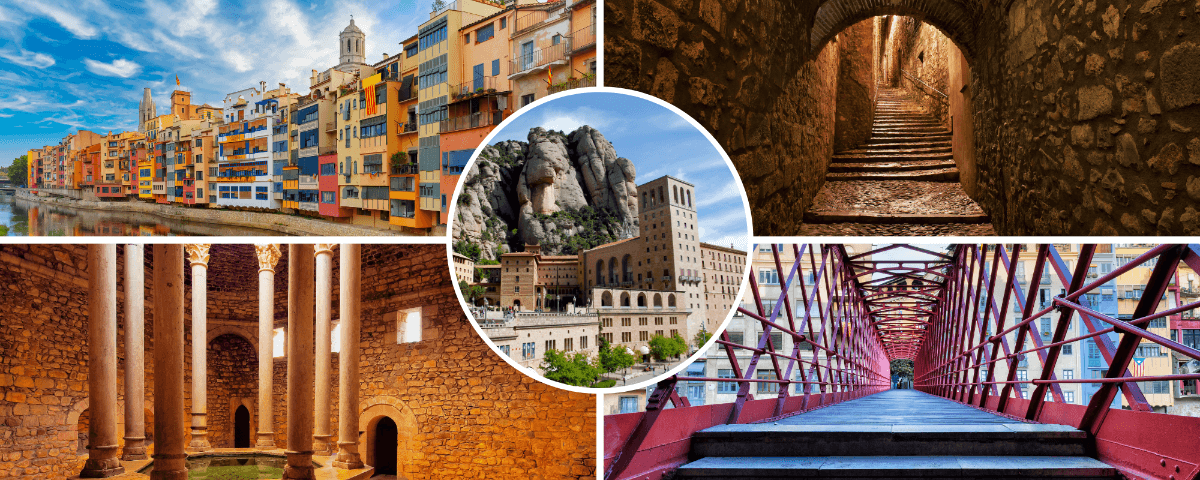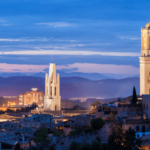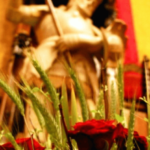
Ultimate Guide To The Girona Cathedral Interior & Exterior
EVERYTHING YOU NEED TO KNOW ABOUT THE CATHEDRAL OF GIRONA
The city of Girona (Gerona in Spanish) attracts many visitors for its history and its scenic old town. And one of its most spectacular sites is definitely the Girona Cathedral (or “Catedral de Girona” in Catalan and Spanish). No visit to Girona is complete without at least seeing it from the bottom of the steps leading to it. But is it worth to go inside? Today we’ll help you figuring out if it’s the right attraction for you!
It’ll be a very personal choice in the end, though. Are you passionate about history? Are you a Catholic or at least a spiritual person? Do you love art and architecture? Do you enjoy listening to legends and stories? The Cathedral of Girona offers that and much more. Keep reading to decide if you should pay to see the interior or if you’ll be fine just seeing it from outside.
History of the Catedral de Girona
1
The Origins

Unfortunately, between 715-785 Girona fell under the control of the Muslims, who turned the original building a mosque. There's nothing left from those times, though: only written documentation about it. The records also mention that after the Francs, led by Charlemagne, expulsed the Muslims from the North of what now is Catalonia, the building went back to functioning as a Cathedral and seat of the bishopric.
2
The Romanesque Cathedral
The Cathedral of Girona (or Santa Maria de Girona, or Catedral de Girona) was probably built on top of what had been the Roman Temple of Gerunda, in the upper area of the Roman town. 516aC is the first time a bishopric is documented in Girona, what means it must have had already an important Christian community. And by the next centuries the records say it had attained a high religious rank.
The first Cathedral from which we can still see parts of the structure still nowadays was built between the X and XI centuries, and was consecrated in 1038. The Romanesque church, of only one nave and narrower than the current one, was finished and that is enough for a church to start working as an active church. The bell towers and the cloister would be completed in the next couple of centuries, still in Romanesque style.
From those times you can see the cloister, one of the two bell towers (now integrated in a side of the Gothic building as a buttress), the altar stone, and the bishop throne, known as Charlemagne chair, the chapel of Saint Peter and some tombs located in the cloister. The Tapestry of the Creation kept in the museum is definitely from the same time frame, but its origins and use are unclear.
3
The Gothic Cathedral
In 1312 started the construction of the Gothic building, that would be build on the same site of the Romanesque one. First was completed the backside, allowing to consecrate the new altar and demolish the Romanesque apse.
In 1386 it was suggested that the original plan of 1 central nave and two side aisles was turned into a plan of one single wide nave. It was a risky project and it wasn’t sure that the available knowledge of architecture would allow them to build that in a safe and stable way. The works stopped and specialists were called to deliberate.
And the discussion lasted 3 decades until in 1417 the bishop had had enough and decided that the church would be continued with only one nave. The works lasted until 1604, with a 12 year break due to the Catalan Civil War. With its 22.98m / 75,39ft, it became the widest Gothic nave in the world, a prodigy of medieval engineering.
The Exterior of the Cathedral
2
Cathedral façades
The main façade is a monumental stone retable made in Baroque style (1606-1733) and crowed by a huge rose window about the Assumption of the Virgin Mary. The sculptures, though, are from 1961-62, and represent Sant Peter and Saint Pau, the Virgin Mary with the Baby, Saint John the Evangelist and Saint Narcissus, patron saint of Girona.
CURIOUS FACT: One of the faces decorating the façade of the Cathedral is a man with a moustache. It is said that Salvador Dali, who was born in the nearby town of Figueres, could have been inspired by it to grow his own moustache. This, or it was a premonition!
3
The famous Girona Cathedral steps
The famous stair to the Girona Cathedral is considered the longest Baroque staircase in the world, with its 90 steps divided in 2 sections of 30 steps each. It was commissioned by the Bishop between 1685-1699: the story says that during his own ceremony of ordination he had such a hard time climbing the original steps, very deteriorated already, that he decided some new and grand stairs were needed. If you pay attention, you’ll see the stone of the steps is full of tiny shell fossils called nummulites.
Game of Thrones in the Catedral de Girona
The famous steps of the Cathedral of Girona appear in Game of Thrones. It’s the Great Sept of Baelor in King’s Landing, during Maragery’s walk of atonement (not to be confused with Cersei’s walk of atonement, filmed in Dubrovnik, Croatia). In the scene, Jammie Lannister rides his horse up the stairs to save her.
The scene involved a lot of computer image editing, to make it look like the Cathedral was set in front of the sea, and that the plaza in front of the steps was much larger to fit in a crowd. The sculptures of the façade were also covered to eliminate religious references. BTW, if you are a GOT fan, don’t miss our post about other Game of Thrones locations in Girona.
Girona Cathedral interior
2
The Naves
Near the entrance you’ll also see some models of the Cathedral that show you its architectural evolution from a Roman Temple to the current building. It’s interesting to also note how the city and the staircase have also changed through the centuries.
From there you can also admire the rose window representing Saint Michel killing a dragon, a symbol of evil. However, you won’t see the altar yet, because the view is blocked by a high wooden piece: the organ. Interestingly, the organ pipes that can be seen are just decorating it: they don’t sound. It’s the over 2000 pipes inside the giant wooden box what produces the organ music.
As you pass the organ you’ll be able to see the Altar, made of white marble and original from the Romanesque Cathedral. The altar is covered by a fine baldachin made of silver, and behind the altar there’s a retable also made of silver, gold and precious stones. There’s also the Bishop throne, made of stone and on top of some steps – but that’s best seen from the deambulatory gallery that goes behind (see below).
The tomb of Ermessenda of Carcassonne
She even tried to get his grandson excommunicated from the Christian church for having married “the wrong woman”. Ermessenda promoted the construction of the Romanesque Cathedral of Girona, as well as the nearby Monastery of Saint Daniel. And at the end of her days, rather than submitting to her grandson power and pledging him loyalty, she preferred selling him her lands and retiring to a castle after 40 years of intense political life. She passed away there a year later, after having expressed her wish to be buried in the Catedral de Girona.
Originally the tomb was located in the narthex (or entrance gallery at the food of the church), but it was moved to this chapel in the 1300’s by order of the King Peter the Ceremonious. The beautiful sculpture of her was also done then, in Gothic Style. Inside that coffin there was another one, that you can see now in the back of the chapel sporting red and golden stripes. It is believed to be one of the earliest representations of the Catalan flag (that later on would be standardized to feature only 4 red stripes).
The tomb of Ramon Berenguer II
He died in the woods between Barcelona and Girona in 1082, probably killed by his twin brother Berenguer Ramon, known now as The Fratricide. The legend says that the northern goshawk that Ramon Berenguer used for hunting led the rescue team to where the body was lying. Back to Girona, the bird attacked Berenguer Ramon and snatched his crown, as if accusing him of having killed his brother.
The Bishop Seat
Did you know that the word “cathedral” comes from Latin “catedra”, that means “seat”? And whose seat? The Bishop’s Seat. Of course, it needs to be understood more in the sense of “headquarters” of the Bishop, but it can also be read as the place where he seats.
The Bishop Seat of the Cathedral in Girona is over 1000 years old and it’s made of local marble. Due to its location behind the altar and on top of a short flight of steps, it’s not easy to see: you’ll have to walk the gallery around the altar to find a good angle.
The locals call it the “Chair of Charlemagne”, who the legend says was the founder of the Cathedral (although the historical documents state otherwise). It’s wide enough to be occupied by two people, and that gave room to a superstition that says that if a couple seats there together they’ll get married within a year, but if someone seats alone, he or she will never marry. And that’s why the seminar students were made to seat there before being ordinated as priests!
3
The Cloister
The decoration of the capitals of the columns are worth paying attention: if you are familiar with the Bible, you’ll be able to recognize many scenes of it. The pillar closest to the entrance Is about the Genesis (Adam and Eve, Cain and Abel, Noah… A bit further you’ll see scenes related to the birth of Jesus: the annunciation to the shepherds, the slaughter of the innocents, the scape to Egypt…
The central pillar of this gallery is about the Apocalypse, with Jesus breaking the gate of Hell, and damned souls burning in the pots of the devils or being eaten by monsters. Try to guess what the capitals represent: there’s more stories of the Old and New Testaments, but also medieval daily life scenes such as monks shaving, people hunting, a variety of mythological animals… Towards the end, as you approach the entrance door again, you’ll see some about the construction of the Cathedral.
But don’t focus only on the capitals: as you walk around the third gallery, opposite to the wall of the nave, you’ll get the best view over the Romanesque bell tower that was reused as a buttress for the Gothic building. A legend says that from the top of that bell tower Charlemagne dropped his sword, that penetrated the earth and continues to sink until the day it’ll reach the other end of the planet and then the Earth will break in two pieces… Too bad Charlemagne never really visited Girona, but it was his son who did.
From there, high above, you’ll also see the only gargoyle of the Cathedral with a human shape. It is said to have been a witch that stoned the Christians from there until God turned her into stone as a punishment.
4
The Treasure Museum
Beatus of Girona
A beatus is a manuscript copy of the Commentary of the Apocalypsis of Saint John written by the abott Beato deLiebana in 776 (Cantabria, Spain). The one in Girona dates back from 975, it was made in a monastery of Zamora but a few decades later it had already arrived to Girona. The words were written by a monk named Emeterious, and the drawings were created by the nun Ende (considered one of the first documented female artists in the world history).
Tapestry of Creation
It is almost a miracle that such a delicate textile piece has survived for 1000 years. Technically it’s not a woven tapestry, though, but a very complex embroidery. Make sure to stop to watch the video about its symbolism before you enter the bottom room of the museum where it’s displayed. There’s so much you can miss if nobody tells you, but once you know it’s easy to identify each scene.
You’ll see the Lord in the centre, surrounded by the Creation of the world: Adam and Eve, the animals of the lands, the sea and the sky, rivers and oceans, the angels of light and darkness, the Holy Spirit… There’s the angels of the wind blowing their trumpets, and representations of the year and its months and seasons, the Sun… And at its bottom can be guessed the trip of Saint Helen to recover the Holy Cross from Jerusalem. Just fascinating!
Cathedral visit information
2
Contact details
Catedral de Girona
Plaça de la Catedral s/n
17004, Girona (Spain)
Phone number: +34 972427189
https://www.catedraldegirona.cat/
3
How to get there
The only way to reach the Girona Cathedral is on foot. It is located in the heart of the old quarters, the Barri Vell, and it’s an entirely pedestrian area. You can reach it from Carrer de la Força if you came from La Rambla, or through the Portal de Sobreportes in the back of the Basilica de Sant Feliu, if you came from the Lioness statue. If you come from the upper part of the walls or the Gironella Tower, you’ll reach the back of the Cathedral via the Bisbe Josep Cartañá street.
If you drove from Barcelona and exited the highway on Girona Oest, there’s several free parking lots around the Rotonda del Pont de Pedret, but they are often full. You might need to use the Parking Saba Berenguer Carnicer nearby. From there, the Pont de Sant Feliu takes you to the Lioness statue.
If you left the highway on Girona Sud, park in Girona d’Aparcaments i Serveis and reach La Rambla via the Pont de Pedra bridge, or park in Saba Santa Caterina and get to La Rambla via Plaça de Catalunya. If you took the train instead, it’s a 20 minutes walk to the Cathedral of Girona, or a 10 minutes taxi ride that won’t save you the walk accross the alleys of the old town.
4
Opening hours and mass times
The Cathedral can be visited Monday to Saturday from 10AM to 6PM, and Sundays from noon to 6PM. There’s an entrance fee that also includes the nearby Basilica de Sant Feliu, an ancient church over 1000 years old. And for a small additional fee you also get to visit the Museum of Art of Girona.
The Girona Cathedral is an active church, with mass celebrated at 9AM in a side chapel (Mon-Sat). On Sunday there’s a morning prayer at 10.30 in the same side chapel, and High Mass is celebrated in the main altar at 11AM, before the Cathedral is opened for visitors.
6
Tours of the Cathedral of Girona from Barcelona
Are you traveling to Barcelona and would love to go to Girona for one day and see this amazing Cathedral? You don’t feel comfortable driving or taking public transportation to get there? You hate to feel dragged up and down with a large group of strangers? Then we might have what you need!
We do private tours from Barcelona to Girona, and it’s also possible to combine Girona with some other nearby destination in one day. Book with us and you’ll have your very own licensed tour guide to spend as much as you want inside the Girona Cathedral and explore the rest of the area. Here are some great tour ideas:
Are you going to visit the Cathedral in Girona?
Marta
RESEARCHING FOR A TRIP IS TIME-CONSUMING…
Need more inspiration?
Our 100% FREE Barcelona Collection will give you everything you need to organize the trip of your lifetime to Barcelona.
BEST INSIDER TIPS FROM THE PROS!

Last update on 2024-04-20 / Affiliate links / Images from Amazon Product Advertising API













